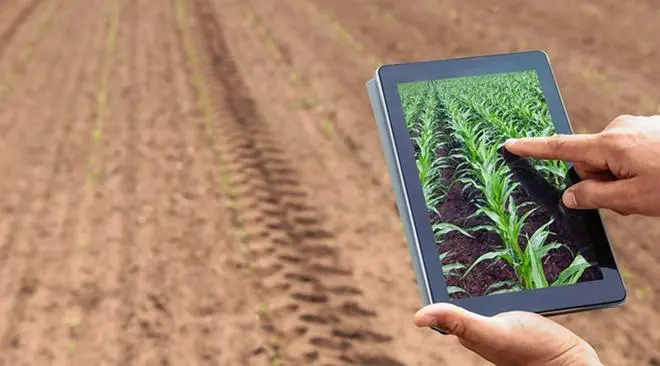From a handful of mavericks taking on complex challenges in 2011, today India has over 1,000 agritech start-ups, all striving to iron out inefficiencies in agricultural value chains. The profile of entrepreneurs driving agritech innovations has also changed over the years. We are increasingly seeing co-founders with elite engineering/MBA pedigrees and prior experience with unicorn start-ups joining the swelling ranks of agritech entrepreneurs. Families no longer balk at the idea of their IIT/IIM-educated child marching off to work with the bottom billion in Bharat. This new wave of agritech start-ups has begun to identify and solve multiple, chronic pain points in Indian agriculture.

Smart agriculture, vertical farm , sensor technology concept. Farmer hand using autonomous assistant robot arms for monitoring temperature , humidity , pressure and light of soil in strawberry farm. | Photo Credit: JIRAROJ PRADITCHAROENKUL
Information asymmetry in rural India has always been one such pain point. Around 2016, rising rural smartphone penetration, ubiquitous 4G connectivity, and the plummeting cost of mobile data provided the backbone for full stack digital agritech platforms to scale massively. These platforms found cost-effective ways to help farmers improve their yields, lower their operating costs, and ensure that their produce gets the right market value. DeHaat is a prominent example here, with its full-stack offering across inputs, advisory, market linkages, and fintech. Younger start-ups like BharatAgri and Krishify are also working to empower the farming community with actionable information that augments their incomes. BharatAgri provides farmers with affordable and accurate scientific crop advisory, and Krishify is building a multilingual social media platform that can revolutionise information, trade, education, and entertainment for Indian farmers and rural communities.
Climate change
Indian farmers also find themselves struggling on the front lines of climate change. Plummeting water tables, depleting soil fertility, and erratic monsoons are only the beginning of a complex web of challenges they will face in the next decade. Fortunately, there has been a rapid development of precision agritech solutions over the past few years, which help farmers reduce expenditures, solve the labour shortage, and navigate erratic climatic conditions. A case in point is the steady adoption of Fasal’s technology, on-farm IoT devices which help horticulture farmers achieve higher productivity, improved yield quality, and increased profitability. As for automation, TartanSense is developing robots for smallholder farms, which reduce chemical usage by 45 per cent, increase weeding efficiency by seven times, and significantly reduce expenditure and drudgery.

Smart agriculture. Farmer using tablet corn planting. Modern Agriculture concept. | Photo Credit: Allexxandar
A more recent development in the agri space is the buzz of start-up activity in white spaces, part of the value chains hitherto untouched by innovations. For example, farmers have always struggled with making informed decisions when it comes to investing in tractors. Tractor Junction’s marketplace is a welcome respite from the prevalent information opacity. Similarly, ReshaMandi is spearheading a digital transformation in the unorganised sericulture sector. Despite India being the world’s second-largest producer of raw silk, unscientific methods of farming, improper storage facilities, inadequate market linkages, and poor access to credit are a few of the challenges that inhibit the potential profitability of the industry. ReshaMandi’s AI and IoT-led digital ecosystem is streamlining the silk supply chain and seamlessly connecting farm to retail.
Agritech funding
As of 2022, India has the third largest start-up ecosystem globally and ranks third after US and China in agritech funding. However, agrifood life sciences (AFLS) as a category is yet to experience the same vibrancy in talent and funding. AFLS refers to four broad categories: agricultural biotechnology, novel farming systems, bioenergy and biomaterials, and innovative foods. Globally, $6 billion was invested in AFLS start-ups in 2020, while their Indian peers, raised slightly over $10 million. It is especially baffling given India’s vulnerability to climate change, as innovations in AFLS can be the most effective weapons in our arsenal. BioPrime’s work with agricultural biologicals is proving just that. Derived from organic matter, these tools can protect the crops from climatic stress, pests and diseases, all without any harmful environmental side effects. The path ahead for Indian agrifood life sciences is long and arduous. However, it is a journey that needs more participation from entrepreneurs, scientists, venture capitalists, and policymakers as the future of Indian agriculture and food systems might very well depend on it.

Indian Farmer angry about his income due to low crop yield, profit or loan repayment while counting money | Photo Credit: lakshmiprasad S
Over the last few years, there has been a paradigm shift in how we measure development in agriculture. From the metric of productivity, we are now tracking and working towards doubling farmer incomes. This human-centered approach is a significant change as we can now measure the direct impact of development efforts and agritech innovations on the farming community. To conclude, the transformation of India’s agricultural sector will not stop because of temporary economic slumps, and the outlook for agritech remains strong.
The author is Managing Partner, Omnivore







Comments
Comments have to be in English, and in full sentences. They cannot be abusive or personal. Please abide by our community guidelines for posting your comments.
We have migrated to a new commenting platform. If you are already a registered user of TheHindu Businessline and logged in, you may continue to engage with our articles. If you do not have an account please register and login to post comments. Users can access their older comments by logging into their accounts on Vuukle.